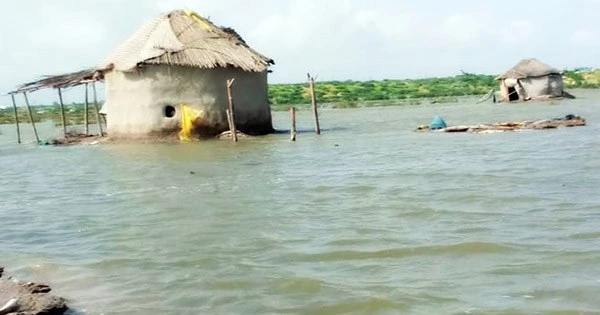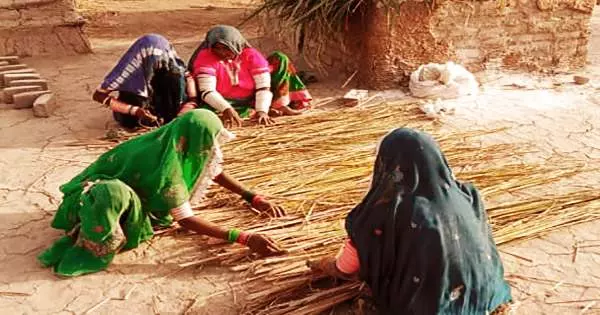# Bamboo is a strong and flexible material that is often used in construction, especially in areas where other building materials are scarce or expensive. Bamboo shelters can be an effective way to provide temporary housing for people who have been displaced by natural disasters such as floods.
33 million people have been affected by Pakistan’s “never-before-seen” floods, and many of them are still looking for safe havens after record monsoon rains damaged or completely destroyed more than a million homes. One-third of the country has been buried by the disastrous flooding that occurred this summer, which was made worse by glaciers melting. According to authorities, it could take up to six months for the water to recede.
Yasmeen Lari, an architect, and the Heritage Foundation of Pakistan have been working nonstop to give the people of Sindh province, which has been severely affected, the knowledge and resources they need to build prefabricated bamboo shelters.
The shelters, called Lari OctaGreen (LOG), can be built by six or seven people within a few hours. They were initially created in reaction to a 7.5-magnitude earthquake that struck northeastern Afghanistan in 2015. As part of a trial project, several hundred households in nearby Pakistan, where the majority of fatalities occurred, were given temporary housing.
In disaster-prone locations, more than 1,200 bamboo versions have been constructed since 2018. (Pakistan is the eighth most vulnerable nation to the climate crisis according to the Global Climate Risk Index, despite European Union data showing that it is responsible for less than 1% of planet-warming gases).
By teaching them how to construct their own homes and assisting them in doing so to create revenue, the project aims to offer individuals in disaster-affected areas a sense of agency as many have lost their means of subsistence. Additionally, communities are taught how to prepare for calamities by digging wells and aquifer trenches to collect rainfall.
“The people who are impacted want to contribute the most,” Lari said in a phone interview, explaining that many of the project’s artisans are from the flooded villages. They have also been helping identify who needs help and how to deliver the prefabricated parts.
“People are sitting under the sky with nothing. They are thinking: How can we work? They have no security, no privacy, no dignity,” Lari said, adding that people “don’t need handouts” but should, instead, be empowered.

‘Treat people as partners’
The shelters are designed to be low cost, low tech and low in environmental impact. “I want it to be zero carbon,” explained Lari, whose foundation has been entirely subsidizing the emergency homes at a cost of about 25,000 Pakistani rupees ($108) each. “I don’t want to create another problem in climate change by building in concrete or steel.”
Bamboo was chosen for its strength and resilience. And, because it’s commonly grown throughout the country, it’s easier to source. The bamboo rods are cut to particular diameters in two workshops before being assembled into kits. The shelters are built on site and consist of a roof, eight robust panels, and a roped-together, mat-covered structure.
Where possible, “everything should be locally-sourced” Lari said. “This is a way to link up the production of housing with how people can earn immediately.”
Marium, who does not have a surname, is currently living in one of the new units with her six children and husband in the village of Pono, in Sindh’s Mirpur Khas district. She explained, speaking through a translator in Sindhi, that reports of adjacent shelters constructed prior to this summer’s floods enduring the catastrophe had circulated. She started asking the other villagers how to get to one. Twenty-five of them have now been built in the vicinity.
Although they are appreciative of the refuge, her family admits they are concerned about things like food shortages and unemployment. Since they believe it to be safer than their former home, they want to know how to make the building permanent.
According to Lari, enough parts for 750 have been fabricated, with a goal to reach 1,200 by early October. Around 350 of the homes have been erected so far.
The figure is “a drop in the ocean,” she said, but production is quickly being scaled up.
For instance, her Karachi-based nonprofit intends to teach 30 artisans from 10 Southern Punjab villages remotely in the upcoming weeks, which will produce an additional 1,500 items each month. The Bank of Punjab is supporting those initiatives by assisting in setting up a location with the tools required to conduct the training. Additionally, it has agreed to send bamboo and other supplies to the artists’ workshops as well as pay the artisans’ wages.
As a quicker, albeit temporary, option, an even more basic variation of the bamboo shelter is also being implemented. It consists of an umbrella-shaped canopy without walls that people may cover with matting.
“I want to create a completely new way of giving,” said Lari, whose disaster relief efforts are focused on capacity-building, sharing knowledge and putting those displaced in charge.
Along with providing shelter, the Heritage Foundation has also been training individuals how to build fish farms, solar water stands, emergency toilets, and other income-generating products including emergency toilets and solar water stands.
A total of nine to ten villages that are close to one of the primary prefabrication locations are currently receiving training in how to make necessities like mosquito nets and the matting used to cover the shelters.
“We have to change the way we work … and treat people who have been affected as partners, not as victims or (those) ready to be made into beggars.”
Barefoot social architecture
In the long-run, the bamboo shelters can be turned into permanent structures. Once the flood waters recede, they can be moved from high ground back into villages, where they are built into foundations made of lime bricks (the Heritage Foundation also teaches brickmaking as a way for people to earn money).
Lari, who is widely recognized as Pakistan’s first ever female architect, says her profession can play a very important role in the climate crisis. But, she added, schools have traditionally been focused on turning out what she called “prima donna” architects. She hopes to someday create an incubator that teaches young designers how to engage in humanitarian work.

A “starchitect” in the 1980s, Lari designed some of Karachi’s glitziest buildings. But she developed a deepening sense of guilt over the amount of concrete and steel used, and has been “atoning” ever since. Her response to this summer’s floods is built upon nearly two decades of what she described as “barefoot social architecture” environmentally-friendly designs that help poor and disadvantaged communities become self-sufficient.
She has also focused on giving women agency and raising their status in a male-dominated society. Her “chulah” cooking stove program, for example, was developed to offer women safer alternatives to the dangerous open-fire cooking used in rural communities.
The stoves are constructed by the participants using layers of mud and lime plaster, and they frequently add paint and custom artwork. More than 80,000 Lari’s chulahs have been constructed as of this writing, serving an estimated 600,000 people.
“Architecture isn’t just about the brick and mortar,” she said. “It’s about seeing how you can help build communities.”
















